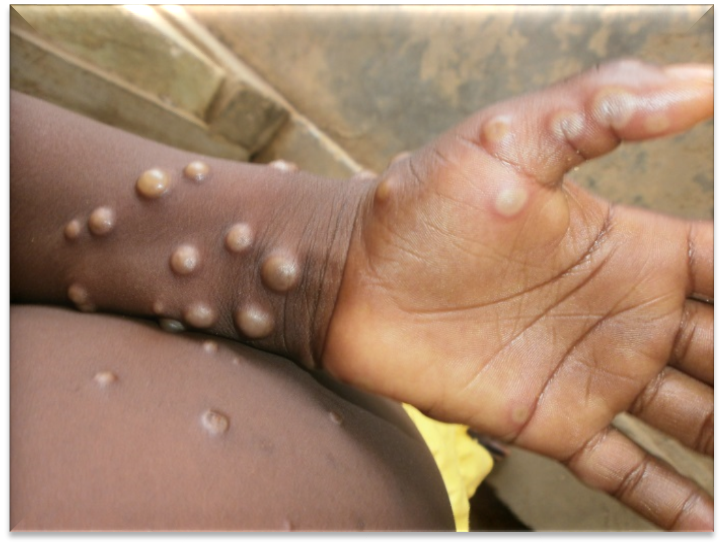What is the Monkeypox Virus?
The Monkeypox virus can be referred to as an orthopox virus that causes a disease with similar but less severe symptoms than smallpox. Although smallpox was eradicated in 1980, monkeypox continued to occur in West and Central African countries. There are two distinct clades that have been identified: the West African clade and the Congo Basin clade, also known as the Central African clade.
Monkeypox is a zoonotic disease: a disease that spreads from animals to humans. The subject cases are often found near tropical rainforests, where there are animals that carry the virus; evidence of monkeypox virus infection has been found in animals such as squirrels, Gambian poaching rats, dormice, different species of monkeys and other animals. The chance of person-to-person transmission is limited and the longest documented chain of transmission is 6 generations, meaning that the last infected person in the chain is within 6 links of the original patient. It can spread by contact with body fluids, skin lesions or internal mucosal surfaces (such as the mouth or throat), respiratory droplets, and contaminated objects.
What are the symptoms of Monkeypox?
In humans, the symptoms of monkeypox are similar to those of smallpox, but milder in nature. Monkeypox begins with a fever, headache, muscle aches, and later leads to complete exhaustion. The central difference between the symptoms of monkeypox and smallpox is that monkeypox can cause swollen lymph nodes (enlarged lymph nodes), while smallpox does not lead to any of that. The incubation period (the time from infection to onset of symptoms) for monkeypox is usually 7 to 14 days, but can be 5 to 21 days.
The disease begins with:
- Fever
- Headache
- Muscle pain
- Back pain
- Swollen lymph nodes
- Shaking chills
- Exhaustion
For 1 to 3 days (and sometimes longer) after the onset of fever, people develop a rash that usually starts on the face and spreads to other parts of the body. Lesions go through the following stages before falling off:
- Stain
- Papules
- Vesicles
- Pustules
- Crust
The illness usually lasts for 2 to 4 weeks. In Africa, monkeypox has been shown to kill up to 1 in 10 people infected with the disease, which clearly defines it’s fatal nature.
How fatal is the situation?
Monkeypox is not a type that one encounters on a daily basis, or even months or years for that matter. It’s a very rare viral infection that can spread from person-to-person via close contact and could result in severe illness, even death; this is why someone recently being diagnosed with monkeypox in England has prompted the U.K. Health Security Agency (UKHSA) to issue an announcement on Saturday.
The UKHSA tends to reserve such announcements for significant news that the general public needs to know rather than things like, “Person has pimple, can’t go to prom.” So before you try to use, “sorry I have monkeypox,” as an excuse to get out of work or a date, keep in mind that others may then call the public health authorities to get you placed in isolation.
The infected person is indeed currently under isolation and receiving treatment at the expert infectious disease unit at the Guy’s and St Thomas’ National Health Services (NHS) Foundation Trust in London, England. The UKHSA didn’t release any details about the person’s sex or age but presumably the person is human. The UKHSA is also working with the NHS to identify anyone who has been in close contact with the infected patient. This includes people who were on the airplane with the person when that individual returned to the U.K. from Nigeria recently.
In this case, close contact doesn’t mean simply exchanging heartfelt texts with many emojis. Rather, it means close physical contact within a few feet as the virus can travel via large respiratory droplets emitted by a person coughing or sneezing. Close contact would also be direct touching an infected person’s body fluids or lesions or objects that an infected person have been contaminated with the virus such as that person’s linens, underwear, shirts, velour track suits, and other clothing. The virus can enter your body via your respiratory track, mucous membranes such as your eyes, nose, or mouth, or breaks in your skin, including non-visible ones.
Most likely, the person caught the monkeypox virus in Nigeria since cases are quite rare outside of certain central and western countries in Africa, as I reported last November for Forbes. The Democratic Republic of the Congo (DRC) had the first recorded human case of monkeypox in 1970. Since then, human infections have popped up in Cameroon, Central African Republic, Cote d’Ivoire, Democratic Republic of the Congo, Gabon, Liberia, Nigeria, Republic of the Congo, and Sierra Leone with the DRC having the majority of such infections.
There have been a smattering of cases in the United States, Israel, Singapore, and the United Kingdom but only in people who have traveled to countries in Africa or come into contact with other animals from such countries. You can catch the virus from other infected animals through getting bitten or scratched by them, eating them, touching their lesions or body fluids, or touching objects that have been contaminated by them such as bedding material. This should make you rethink your plan to go halfsies on a single-bed hotel room with a coughing rodent with lesions.

